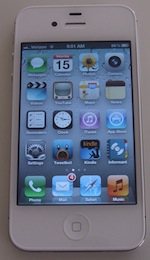iPhone 4S: Day 1 with an Android phone owner


Verizon quoted me a delivery by Oct. 21 which I figured was due to the number of orders in the system prior to mine. I was delighted when I received the notification that my shiny new iPhone 4S would be delivered on launch day (yesterday). Having spent a full day with the iPhone it's worth sharing my thoughts so far, given my heavy investment in Android.
Activation experience
Verizon did a great job with simple, clear instructions for getting the iPhone activated and ready to go. The whole process of activation and setup took only 20 minutes, which contrasts sharply with online reports from AT&T buyers who spent hours due to the carrier's servers being slammed.
Activation of the iPhone was the first step of the process, followed by copying all of my existing information (apps, music, photos, videos) from iTunes to the phone. My stuff totaled almost 20 GB, and given the entire first sync/activation took only 20 minutes was nicely done.
My last iPhone was a 3G on AT&T which I gave up years ago in favor of webOS and Android phones. The abysmal service I got from AT&T back then was the primary reason I switched from the iPhone. I also owned the original iPad which I sold way back when, and currently have an iPod Touch. I wasn't a newbie to the iPhone/iTunes ecosystem by any means.
Before the iPhone was delivered, I took some simple steps to get ready for it that I hoped would streamline the setup of the new iPhone 4S. I updated OS X Lion on the MacBook and iTunes to get ready for iOS 5 and the iPhone 4S. I also updated iPhoto and iMovie on the Mac which I had put off since I didn't need it, but the iPhoto update was required to support Photo Stream on iOS 5.
I then turned my attention to the new kid on the block, iCloud. The appeal of using iCloud with the Mac and iPhone is broad, but I was concerned how well this would work given my entrenchment in the Google cloud.
I use Gmail, Google Calendar, and Google Contacts extensively, and that has worked flawlessly with my Android phone and tablets. I have iCal on the Mac set to sync with my Google calendars, and that has worked great. AddressBook on the Mac works with Google Contacts, and Mail with my Gmail account.
The first thing I did to test iCloud was sign up on the Mac, and then play around with the iCloud settings. It took several iterations of cycling iCloud syncing before I saw my contacts and calendar stuff in iCloud through a browser. I don't know why it didn't take the first time, but it finally did.
I heard a nasty rumor that some new iCloud users that sync with Google Calendar have seen years of Google Calendar events deleted by iCloud. I haven't verified that is the case, but I didn't want to take a chance with my vital information so I carefully chose a setup on the iPhone that avoids the issue for now.
On the iPhone 4S I set up my Gmail account to work with Mail, my Google Calendar to sync with the iPhone directly, and the same for my contacts. I did this by initially turning off iCloud on the phone until I made sure all of my information came over from the Mac via iTunes. Once I verified everything was there as expected I turned iCloud on for everything but calendar. I'll turn that on once I am confident the rumors I've heard are not valid or that the problem has been addressed by Apple.
First impressions of hardware
My iPhone 4S is a white model with 32GB of memory. I went with that as my music collection (iTunes and Amazon MP3 combined) is 16GB and I wanted to get it all local on the iPhone. The first thing that hit me when I took the phone out of the box was how heavy it is. I am used to testing many Android phones, and the iPhone 4S is the heaviest of the lot. It's not so heavy to be uncomfortable, but it is noticeable.
I was curious to see how the updated processor in the iPhone 4S would affect the performance. I was especially curious how that performance would compare to all of the Android superphones I have owned and tested. Let me state for the record that the iPhone 4S is very fast. Things happen immediately when triggered by the user, noticeably faster than any Android phone I have tested.
It's not just the processor speed, it's the graphics system, and both of those optimized tightly with the apps. Opening a complicated web site in the browser results in the complete page appearing almost instantly, far faster than any Android browser I have used on any Android phone. It is impressive.
The camera of the iPhone 4S has been improved over previous models, and it is sweet. I am no photographer, but capturing nice images on the iPhone 4S is as simple as pointing and clicking. I've noticed the autofocus logic is extremely fast when framing a complex shot, and the software seems to pick the proper object in those shots to center the focus on it. It's uncanny to watch the focus brackets figure this out much like a human would.
Software, impressions of Siri, and should Android be worried? »
Software first impressions
The software on the iPhone 4S with iOS 5 is really good. The interface is nicely constructed for easy usage, and the touch controls operate smoothly and lag-free. The UI lacks the customization and sophistication of Android, but so far I don't miss that at all. The iPhone OS is designed to let you just pick up the phone and do stuff without getting in your way, and I am liking that simplicity.
Syncing my Safari bookmarks from the Mac/iCloud to the iPhone took several tries, but they finally appeared. The browser is simply marvelous, from the aforementioned speed to the easy interaction with it. While the 3.5-inch display is not as good for web browsing as on phones with larger screens, it's not bad.
Having all of my iTunes/Amazon MP3 music on the iPhone is wonderful, especially having all of my playlists. I set up Wi-Fi syncing with iTunes on the Mac and that is working nicely after the initial wired syncing. It's pretty cool opening iTunes on the Mac and seeing it sync with the iPhone wirelessly.
I have already been busy making folders in iOS to organize my apps, but it will take some time to figure out the optimal method. I like how you just drag an app to another app to create a smartly named folder based on the app type.
I really like the ability to double-tap the Home button to get to recent apps. I already find I rarely return to the home screen, I simply jump from app to app with this method. It is simple yet elegant in function.
While a common complaint that the iPhone doesn't do real multi-tasking, I am finding that opening an app that has been sitting in the background exhibits zero lag. Tap the icon and the app instantly appears ready to use. This is far better than app switching in Android, in my experience.
Siri, can you help me?
When the servers are cooperating Siri is a wonder to behold. What's impressive is how Siri learns about the user as more commands are entered. Remember, a new iPhone 4S owner is an unknown to Siri. Example, right after activating the phone, I told Siri to "Text Sheri that I'll be home shortly." Siri's response was to pop up a contact card that she believed was the correct one (it was), to allow me to confirm that Sheri as the right one. Siri knows that Sheri is the proper contact from that point on, and completes my requests with ease.
These are just simple examples of what Siri can do as I have only begun to scratch the surface. The key to the utility of Siri is how she learns through usage about me and my world. I see big, big things in the future for this technology, and I am more excited about it after getting exposed to it than I was prior.
I just noticed that I am already referring to Siri as "she" due to the female voice used to converse with me. This was not intentional, it is a result of the powerful nature of the Siri assistant functionality. Siri is already becoming very real to me.
Should Android be worried?
Given my heavy investment in both Android phones and tablets, I am already getting asked if the iPhone 4S is a threat to the platform from Google. There is no correct answer to that, as mobile technology is a very personal thing. I believe those currently using Android phones due to the flexibility and customization possible with the OS will be much happier sticking with Android.
Those who are overwhelmed by Android, and I hear daily from such users, may want to think about going simple. There is no loss of functionality using the iPhone 4S compared to Android, it's just much easier. You give up the ability to customize how the interface looks, but truth be told that is just window dressing.
Related:
- Why I ordered an iPhone 4S
- The hurdles to overcome for voice control
- I want my smartphone to “get” me
- iPhone Great Debate
- HP TouchPad: Everything you want to know
- HP’s TouchPad fire sale: The fallout
- HP punts on WebOS, discontinues TouchPad, cuts outlook
- A tale of two failures: Microsoft’s Kin and HP’s TouchPad
- webOS: A compelling OS that never appeared on great hardware
- Five lessons tablet OEMs can learn from HP TouchPad fiasco
- Samsung Galaxy Tab 10.1 Honeycomb tablet
- Top Android apps for Honeycomb tablets
- Verizon is finally taking pre-orders for Samsung Galaxy Tab 10.1 4G
- Android Honeycomb 3.1: A mixed bag of meh
- Top Android apps for Honeycomb tablets- Summer 2011 edition